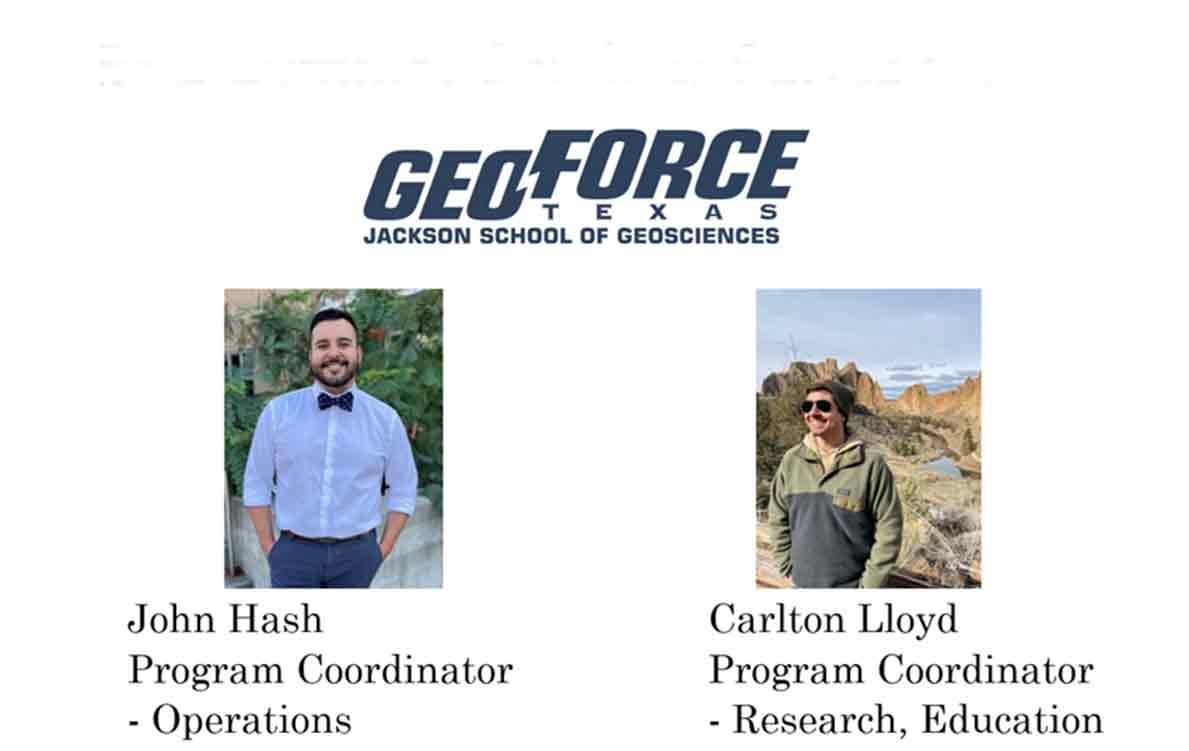GeoFORCE
John Hash / Carlton Lloyd
GeoFORCE is an educational model that gives students from socioeconomically disadvantaged and underrepresented backgrounds an opportunity to explore STEM through Earth processes. GeoFORCE recruits talented and diverse students – rising 9th graders to students entering their first semester of college – from across Texas to participate in week-long educational academies. GeoFORCE students and staff develop cognitively, affectively, socially, and professionally through student-centered learning practices, active-learning strategies, scientific teaching, and a robust support network of staff and mentors. Due to the demographics GeoFORCE serves, GeoFORCE may be used as a model to tackle systemic, institutional, departmental, and classroom barriers for students from diverse backgrounds. GeoFORCE is a collaboration of individual donors, corporate sponsors, federal and state agencies, and academic institutions. This partnership provides an opportunity for individuals looking to assist the next generation of scientists in cultivating their sense of discovery, enhancing their self-efficacy, and developing an identity strongly aligned with the GeoFORCE experience, JSG, UT Austin, and STEM as a community.
John Hash: John is from San Antonio, Texas. He graduated from The University of Texas at Austin with a BA in Government and History. Before joining GeoFORCE, John worked with Advise TX as a College Adviser at Roosevelt HS in San Antonio, where he assisted students in SAT/ACT Prep, College Applications and Financial Aid. John has been a GeoFORCE Coordinator for over 10 summers. He is a GEAR-UP partner and leads budgeting, safety, and communication with professional mentors for the summer academies.
Carlton Lloyd: Carlton earned his BA in Geology from the University of Colorado Boulder with an emphasis on thermochronology, and his Master’s specializes in geoscience education research, specifically bridge programs (i.e., GeoFORCE). Prior to his education at CU, he served in the Marine Corps for five years as an intelligence specialist, taught as a wilderness skills instructor at a youth camp, and served as a backpacking guide in the Sierra. He has worked in STEM and youth education for over five years, ranging from 2nd grade to undergraduate students. He leads educational content development and research initiatives.
The Lower Cretaceous Hensel-Glen Rose Stratigraphic Couplet in the Llano Uplift, Central Texas
Peter R. Rose, Ph.D., C.P.G., Founder and Senior Associate, Rose & Associates, LLP
RSVP to AGS Meetings HERE
ABSTRACT
The Lower Cretaceous Hensel Sandstone and Glen Rose Formation are lateral facies of the transgressive clastic/carbonate leg of the Trinity Division (or Group), whose stratigraphy in the area of the Llano Uplift is here mapped and characterized as a single depositional episode. The Hensel Formation represents alluvial fan, fluvial, and coastal-plain depositional settings, whereas mixed terrigenous and carbonate sediments of the overlying Glen Rose Formation represent peritidal and shallow-marine environments of deposition.
The Hensel-Glen Rose stratigraphic couplet (hence H-GR) thickens from the Llano Uplift eastward toward the Gulf of Mexico and southward toward the Rio Grande embayment. The Glen Rose lithosome thins northward to zero across the southern and eastern margins of the Llano Uplift, primarily by facies change into Hensel arkosic clastics. Reciprocally, the Hensel lithosome thins eastward and southward by grading into Glen Rose strata, so that only thin terrigenous Hensel sandstones and mudstones are present at the base of the downdip H-GR.
At the start of H-GR deposition, the Llano Uplift was a hilly promontory projecting southeastward into the Late Aptian Gulf of Mexico and Rio Grande Embayment. Within the Uplift, the H-GR consists of poorly consolidated arkosic conglomerates, sandstones and mudstones. Its thickness varies widely due to the paleotopography of the underlying Wichita Paleoplain (hence WPP). The H-GR is thin or absent over high-standing Lower Paleozoic fault-blocks, and thick over low-standing Precambrian terranes and “mini-basins.” Hensel Sandstone thickness and configuration of the underlying WPP are mapped throughout the Llano Uplift based on such observed patterns around its margins.
The east-flowing precursor Llano River was the primary stream draining the interior of the promontory. The eastward course of the present Llano River coincides closely with its WPP valley, even though the WPP landscape had been completely filled-in and covered by the time of early Edwards deposition. The south-flowing Kimble valley drained the southwestern quadrant of the Llano Uplift, generating thick deposits of Hensel terrigenous clastics.
BIOGRAPHY
Peter R. Rose (BS, MA, PhD, Geology, University of Texas at Austin) is a certified petroleum geologist who was Staff Geologist with Shell Oil Company; Chief, Oil and Gas Branch of the U.S. Geological Survey; and Chief Geologist and Director of Frontier Exploration for Energy Reserves Group, Inc. (now BHP Petroleum (Americas), Inc.). In 1980, he established his own independent oil and gas consulting firm, Telegraph Exploration, Inc. His clients include most major U.S. companies and many prominent independents as well as many international firms and state oil companies. Dr. Rose has explored for oil and gas in most North American geological provinces and has published and lectured widely on U.S. resource assessment, basin analysis, play development, prospect evaluation, and risk and uncertainty in exploration. He has taught extensively at the professional level and was a 1985/1986 AAPG Distinguished Lecturer. Since 1989 he has been deeply involved in design and implementation of comprehensive exploration risk analysis systems for executive management of many major and independent oil companies, operating in both the Domestic and International theaters. His courses emphasize the link between geoscience and making money in the business of petroleum exploration. He is a Senior Associate in the consulting firm, Rose & Associates, LLP (R&A), which he founded in 2000. The firm is a recognized international leader in risk analysis of exploration and development petroleum ventures. Dr. Rose was the 1996/1997 President of the American Association of Petroleum Geologist’s Division of Professional Affairs. He received the coveted Parker Memorial Medal from the American Institute of Professional Geologists in 1998 and was awarded Honorary Membership in AAPG in 2002. He served as President of the AAPG beginning in July 2005. In 2013 he became the first American recipient of the prestigious Petroleum Group Medal of the Geological Society of London, and in 2014 AAPG honored him with its Halbouty Outstanding Leadership Award.
Ethics and Geoscience Practice in Texas 2022
Mark N. Varhaug, P.G., C.P.G., TBPG, AAPG, Beacon Hill Energy President
Biography:
Mark N. Varhaug, P.G., C.P.G., of Dallas, serves as an appointed member of the Texas Board of Professional Geoscientists where he is Secretary/Treasurer of the Board and chairs the Application Review and Continuing Education Committee. He is also Secretary of the Southwest Section of the AAPG. Mark has more than forty-five years’ experience in the practice of geoscience in the US and internationally. He is currently President of Beacon Hill Energy, an independent exploration firm in Dallas.
Mark received a Bachelor of Science in geology from Southern Methodist University. He is a Licensed Professional Geoscientist in Texas and Louisiana and an AAPG C.P.G. He is a member of the Dallas, Houston, and West Texas Geological Societies; the Geological Society of America; and is a Life Member of the Society of Petroleum Engineers.
Geological and Techno-economic Research for a Hydrogen Economy
Dr. Mark Shuster, Associate Director: Energy Division, The Bureau of Economic Geology
Biography
Mark Shuster is responsible for managing the Bureau's energy-related research. He joined the Bureau in September, 2016. Prior to joining the Bureau, Mark worked for Shell and affiliates for 30 years in upstream oil and gas roles around the world. Mark began his professional career as a Research Geologist working on projects on the Permian Basin, Atlantic margin basins and southeast Asia. Subsequently, Mark worked on exploration and appraisal projects in Venezuela, Australia, Middle East, Gulf of Mexico and most recently, Alaska. Mark received his Bachelor of Science degree in Geology from the University of the Pacific and his PhD in Geology from the University of Wyoming.
Poster Session
AGS Poster Session – 6:30pm to 8:00pm
Bureau of Economic Geology
Parking $6
A Systematic Approach to Identifying Hydrocarbon Sweet Spots Using Integrated Seismic Multiattribute, Wireline-Log, and Core Analyses
Dr. Osareni (Chris) Ogiesoba, Research Scientist with the UT Bureau of Economic Geology
Presentation Summary
Dr. Ogiesoba will discuss results of an investigation conducted to determine hydrocarbon sweet spots distribution within the Campanian Taylor sandstone in Serbin field, covering 56 mi2 (~90 km2) and straddling parts of Lee, Bastrop, and Fayette Counties in southeast Texas. By integrating 3D-seismic-multiattribute analysis, neural network techniques, and core data, we demonstrate that (1) hydrocarbon sweet spots are laterally separated by mudstones and calcite- and quartz-cemented sandstones, (2) within the Taylor sandstones in Serbin field, porosity increases with depth, and (3) the Serbin field is separated into two areas: (i) a diagenetically altered, high-impedance, low-porosity rock area in the western section, and (ii) a low-impedance and relatively high-porosity sandstones area located in the eastern section.
Biography
Osareni (Chris) Ogiesoba is a Research Scientist with the Bureau of Economic Geology, Jackson School of Geosciences, The University of Texas at Austin. He holds a Ph.D. in earth and planetary sciences from McGill University, Canada, and M.Sc. in geophysics from Imperial College London, UK. Prior to joining the Bureau in 2007, Dr. Ogiesoba worked for Mobil for 19.5 years and was instrumental in the discovery more than 1 billion bbls of oil for Mobil. His research interests are in seismic interpretation, seismic attributes, inversion, and converted-wave seismic exploration. He is a member of SEG and AAPG.
AGS Spring Field Trip
The Wichita Paleoplain in the Llano Uplift, Central Texas. Leaders: Peter R. Rose, Thomas E. Ewing, and Charles M. Woodruff Jr.
Date: Saturday, March 26, 2022 (Rain Date: Saturday April 2).
Please see this link for details
Please sign up for the field trip at this link: https://www.surveymonkey.com/r/6HPXWMR
Volcanic induced mass-wasting complexes in the Upper Cretaceous (Early Campanian) Austin Chalk strata in the Maverick Basin and San Marcos Arch areas of South and Central Texas, USA
Robert G. Loucks and Robert M. Reed
Biography
Robert Loucks is a Senior Research Scientist at the Bureau of Economic Geology. He received his B.A. degree from the State University of New York at Binghamton in 1967 and his Ph.D. from the University of Texas at Austin in 1976. His general research interests include carbonate and siliciclastic sequence stratigraphy, depositional systems, diagenesis, and reservoir characterization. His latest research includes a regional investigation of the Austin Chalk producing trend. He has authored or co-authored more than 200 papers. He has twice received the Wallace E. Pratt Award for best AAPG Bulletin paper and twice received the A. I. Levorsen Award for best paper at GCSSEPM and WTGS. He was also awarded the Karst Waters Institute 2014 KWI Karst Award and the AAPG Robert R. Berg Outstanding Research Award.
The Emerging New Geothermal Paradigm
Dr. Kenneth W. Wisian, Associate Director: Environmental Division, The Bureau of Economic Geology
Biography
Ken Wisian, Ph.D., Major General USAF (retired), is responsible for coordinating environmental related research. He came to the Bureau from the Center for Space Research. Previously, Dr. Wisian was a senior state executive responsible for disaster recovery, oil spill prevention and response, and coastal infrastructure and environmental protection for Texas. As a military officer, General Wisian participated or lead military disaster response efforts for the Shuttle Columbia crash and multiple hurricanes. Dr. Wisian is a geophysicist whose main research is in geothermal systems, modeling, and instrumentation & data analysis . Other current research includes; autonomy/drones, applied gravity, planetary geology/space exploration, infrastructure resiliency and international relations.










